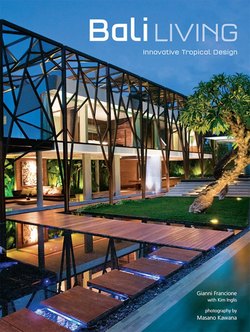Читать книгу Bali Living - Gianni Francione - Страница 10
На сайте Литреса книга снята с продажи.
ОглавлениеThe “front” of the main triangular building somewhat resembles a ship’s prow. With a small garden and lily pond around, it is clad in grey paras stone to support the beautiful curved “flying” roof.
following the
lay of the land
Built in 2004 as guest quarters for the home featured on pages 136–147, the form of this two bedroom home is dictated almost entirely by the shape of the land within which it snuggles. Sandwiched on one side by an access road and on another by a steep gorge, the house is almost in-built into the land. “The challenge was to make the house disappear from the driveway while totally integrating it into the tropical scenario,” explains a spokesperson for GM Architects. This is fully realized, as it is only the singular shape of its two roofs that alerts passers-by of its existence.
The brief was for something “cute and different”, and the architects accomplished this mainly through the two curved roofs that resemble the upside-down keel of a boat. The larger one is 22 metres (72 feet) long and both were constructed, pre-assembled at a workshop elsewhere in Bali, then cut into sections and reassembled on site. This was achieved by Tropical Buildings, a company that specializes in building stand-alone structures that can be packed and re-assembled in a different location at a different date.
The house comprises two buildings, a smaller one with a single bedroom and bathroom, and a larger main one, with living/dining quarters and one further bedroom. They are interconnected by a sequence of curved surfaces—walls, pools, decks, paths—that follow the natural contours of the land as it drops dramatically down to the river. These also help to fully integrate the home into the surrounding landscape and vegetation.
Needless to say, it isn’t only the roofs that give this house character and substance. Certainly they offer an internal feeling of protection, as well as excellent natural ventilation, but there are other features of note. The use of materials—wood, natural stone (paras and palimanan)—and furniture crafted from shells, bones and coconut shards gives the house an earthy, organic quality suitable for indoor/outdoor tropical living. Of particular note is the open-plan living and dining areas: Situated over two levels with open access to deck and pool, the entire space is a pleasing mix of curved and perpendicular volumes, hard and soft surfaces, and light and dark shades.
If one were to view the home from an aerial perspective, the two volumes would look a little like two turtles crouching down into the surrounding vegetation. But when one is at ground level, all is airy, light, breezy and natural—and the surrounding trees, grasses, water plants and ornamentals are not merely surroundings. They are part of the entire whole.
Precision cutting, curvy shapes and a natural flair for organics such as coconut, bone and penshell result in some beautifully crafted decorative pieces from the atelier of Etienne de Souza.
The open-plan living room, wrapped by a soaring timber roof propped by a large V-shaped support, leads out to a palimanan stone deck on right and has a raised dining space behind, which opens up to another upper wooden decked terrace outside. A teakwood sculpture by Yasukazu Nishihata for Nakara complements teakwood flooring and a décor theme of organics.
Wood decking, lawn, water and pebblewash and terrazzo are only some of the surfaces used in this entirely natural home.
Elegent detail of a long bench made from Tahiti mother-of-pearl by Etienne De Souza.
The compact upper dining area features some furniture designed by Etienne De Souza from natural materials: of particular note is the square grillage table in bone-and-shell strips with legs in metal and resin with matching chairs in the foreground. Artworks are in keeping with the general organic theme—a painting by Peter Dittmar and a triangular teakwood art-piece from Ideas. The floor is composed of ivory palimanan to distinguish it from the teakwood section below (seen here on far right).
The open-plan living area, with warm teakwood floor, features a low square sofa and coffee table constructed from bone shards; the camel-toned upholstery is in suede. The duo complement the coconut and penshell tray on the coffee table and the standing lamps in bone and shell. All were designed by Etienne De Souza.
Precision cutting, curvy shapes and a natural flair for organics such as coconut, bone and penshell result in some beautifully crafted decorative pieces from the atelier of Etienne De Souza. They work well in this airy, organic-themed home. Above left shows some art stools in the foreground and a pair of “botero” vases in bone and penshell stripes; above right details the bone and shell star pattern of the coffee table.
The entrance to the villa is via a curved pathway that leads off the main access road. Two similarly-shaped curved shingled roofs shield both buildings: On the right is the master bedroom and bathroom, while, on the left, the somewhat larger volume houses the living and dining areas, the kitchen and another bedroom.
